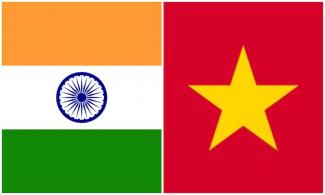India-Vietnam Space Cooperation: Looking for New Frontiers
The 21st century is rapidly developing in various East and Southeast Asian parts. The developing states in the region are struggling to maintain a balance between their social obligations and economic reforms. They believe that technology could act as a catalyst for the successful implementation of their development strategies. During the last few years, the Vietnamese government has invested significant resources in developing its science and technology base, keeping in mind its long-term interests. Space technology is one such area identified by the Vietnamese government.
It would be interesting to note that space technology issues have made inroads in Vietnam’s strategic thinking since 1980. The beginning was made by the UNDP’s projects to promote the utilization of satellite data for survey purposes, particularly under the joint Soviet Union-Vietnam space flight cooperation. Interestingly, the first Asian in space was a Vietnamese cosmonaut, Pham Tuan (now retired Lieutenant General), who flew in July 1980 under the Soviet Interkosmos space exploration programme.
In 2006, the Vietnamese government announced the “Strategy for Space Technology Research and Applications Until 2020,” which lays down plans to develop communication and earth observation satellites. In April 2008, a medium-sized 2.6-ton satellite, Vinasat-1, was put into geostationary orbit using a rocket Ariane-5 launcher from French Guiana. It took nearly 13 years to complete this project, which was approved by the government in 1995, focusing on providing low-cost communication services. The first satellite has a life span of 15 to 20 years, and the project's contractor is the US aerospace giant Lockheed Martin.
Vietnam also had difficulty obtaining a geostationary orbit position. The Vietnamese satellite is located at a longitude of 132 degrees east, which Japan also uses. They had to undergo intense negotiations since the International Telecommunication Union (ITU) governs the use of slots at the global level.
Vinasat-1 is a commercial communication satellite; however, the capability of this satellite is not been utilized fully because of the lack of clientele. In 2009, only 30% of its capability was used, but slowly, the situation is changing. The initial absence of customers could be mainly attributed to the overall economic slowdown of the market. From Vietnam’s point of view, the availability of such satellites is a boon because it would have to spend otherwise ‘almost 15 million US dollars annually to rent satellites of foreign countries such as Russia, Australia and Thailand’.
Vietnam plans to launch its second satellite into orbit, and France is expected to provide the technology and official development assistance (ODA) for this project. This small satellite would be used for natural resources development, environmental study, and disaster monitoring (VNREADSat-1). It is planned to be ready by 2012.
Vietnam's lack of a rocket science base demands it look for partners. Japan is emerging as a major partner in the space arena. A few months ago, an ‘in principle agreement’ was reached between the two countries whereby Japan would provide development assistance to launch satellites. Japan will likely offer 7 billion yen to develop and manufacture two earth observation satellites to monitor natural disasters. Naturally, orders for satellite manufacturing can be expected to be given to Japanese companies, and Japan is even proposing to launch one satellite. This is one of the biggest ODA plan for Japan and is expected to boost their space industry. Also, Japan would help construct a space centre in Vietnam and provide financing aid for training satellite engineers.
States like Japan and France are currently tapping Vietnam’s increasing interests in the satellite field. However, Vietnam’s space development policy clearly suggests that there are opportunities for other actors, too. For a state like India, which has a highly developed space programme, it is time to look for new partners and markets. In fact, Vietnam’s interest in this area provides an ideal opportunity for India.
Indo–Vietnam relations have a long history. Recently, issues such as terrorism and trade have been at the forefront of their bilateral relationship. More than 35 years ago, India granted Vietnam MFN status. Vietnam advocates India's importance for ASEAN and supports India’s quest for permanent membership of the UN Security Council. Considering the strategic importance of India-Vietnam relations, both partners could explore collaboration in the space arena.
India could offer help to Vietnam in various domains of space technology, including satellite supply and launch services. India could also develop structures for satellite data sharing. Rocket science education is another area in which India could offer help. Also, Vietnamese students engaged in space research could avail of graduate programmes in aerospace engineering. A few joint programmes could also be planned, and Vietnam’s scientists could be employed with India’s major projects, like the Moon Mission, etc, to offer them exposure to emerging areas of space science.
India and Vietnam could also consider creating a consortium with other states in the region to develop a multilateral mechanism that allows them to jointly express their views on space security. The issue of space security and the imminent weaponisation of space demand immediate attention, particularly given China's anti-satellite test (ASAT) in 2007.
A Beijing-led intergovernmental organization with full international legal status, the Asia-Pacific Space Cooperation Organization (APSCO), has been operating in the region since 1992. States such as Pakistan, Iran, China, Thailand, Turkey, Indonesia, etc., are members of this organization. Interestingly, states like Japan, India, and Vietnam are not on board. All such realities indicate the scope and need for Indo-Vietnam space cooperation.
